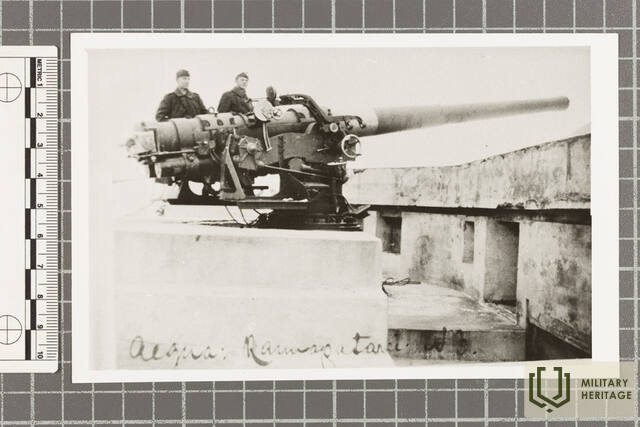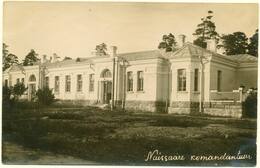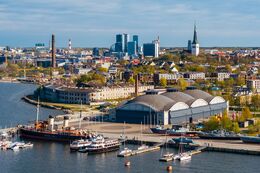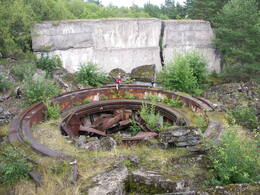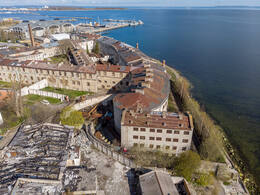Peter the Great's Naval Fortress I World War I
Russian fortification line constructed before and during the First World War from 1912 to 1918 as part of the defence of Saint Petersburg, the capital of the Russian Empire, in both Estonia and Finland.
The fortification of the road to Saint Petersburg became a priority after the Russian defeat in the Russo-Japanese War (1904-1905). The main Tallinn-Naissaare-Porkkala line is known as Peter the Great's Naval Fortress, which was the most important and fortified part of the network of defences.
The network of fortifications comprised naval and air defence batteries, bunkers, trenches, fortified railways and highways, bridges, harbours, dockyards, military bases and many more.
The naval fortress was unfinished and in 1918 retreating Russian forces blew up and destroyed some of it. Despite this, the newly formed Republic of Estonia managed to build up its coastal and naval defence on the basis of the fortification line. The structures on the island of Aegna were developed the most.
The fortifications were seldom used in the following wars, as warfare had significantly changed by that time. After major nations abandoned artillery-based naval and coastal defence practices in the 1950s, the facilities continued to be used only as warehouses.
Today, almost all the fortifications have been decommissioned and are open to tourists.
Related objects
Naissaar
This island, which covers 19 square kilometres in the Bay of Tallinn, was acquired by the Imperial Russian Navy in 1912, forcing out the locals. The navy built ports, railways and coast batteries as part of Peter the Great's Naval Fortress on the island. During World War I and the War of Independence, the island also held a prisoner-of-war camp. The newly independent Republic of Estonia retained the island as part of the established coastal defence system, but allowed the locals to return to it. During the Soviet occupation, the island was under the control of the military, who built a naval mine depot and factory there. The buildings and equipment left behind on Naissaar by the Soviet Army can still be partially explored today. The network of bunkers designed to form the naval fortress goes deep underground. Some of the bunkers and artillery mounts are still accessible. A full tour of the island can be taken in a day. The island used to be covered with a dense railway network connecting the military facilities. This is why the remaining tracks are a great trail guide for touring the island.
Naissaar is home to 40 kilometres of narrow gauge railways, the laying of which began in 1913 during the czarist era. The railway network was also partially used during the era of independence and during the Soviet occupation. Today a 2.4 kilometre segment of it has been restored. The Museum of Coastal Folk has various exhibitions on display for visitors to the island providing a more elaborate overview of the island's history. A military exhibition is on display in the Soviet-era career soldiers' living quarters in Männiku village, which showcases both the island's earlier and more recent military past. Naissaare lighthouse is hosting an exhibition called 'Naissaar on old postcards', which depicts the island during its heydays.
Seaplane Harbour
The Seaplane Harbour is situated on the water’s edge in the Kalamaja district of Tallinn.
It was commissioned during World War I by Russian Emperor Nicholas II as part of Peter the Great's Naval Fortress. The museum, based in the historic seaplane hangar, has around 200 original exhibits on display: the submarine Lembit, the 100-year-old icebreaker Suur Tõll, the seaplane Short 184, the oldest Estonian shipwreck, mines, cannons and more. Temporary exhibitions complement the main exhibition. The seaplane hangar is architecturally unique: its domed roof was one of the first thin concrete shell structures of its kind.
The museum’s programmes and materials for individual visits are fun and educational for adults and children alike.
Aegna Island
The three square kilometres of this island in the north-eastern corner of Tallinn Bay are the site of an extensive network of coastal defence batteries and a three-kilometre narrow-gauge railway built before World War I as a continuation of the fortification work begun by Peter the Great in the 18th century. Construction of the Alexander Nevsky Battery began in 1915. The 180-metre concrete structure was coupled at both ends with barbettes supporting two 12-inch guns each. The guns at the eastern end were higher than at the western end, allowing them to be fired westward over the other guns. Battery No. 3 was built on the western shore of Aegna and was ready for combat by autumn 1916. The battery was first planned to have six 130-mm guns, but in the end it was only equipped with four.
In 1918, following the declaration of the independence of Estonia, the coastal defences were taken over by the Estonian Navy. The island had residential housing, barracks, an officer’s mess, staff headquarters, a bread factory, a library, a clinic, a bathhouse and more. The command centre on the island was completed in 1927 in Eerikneeme. Battery No. 10 was also completed that year, equipped with three 75-mm anti-aircraft guns (with a barrel length of 3.75 m) capable of firing up to 6 km in altitude. The importance of Aegna in the coastal defence of Estonia is reflected in the fact that, at its peak, half the men serving in the Naval Fortress Division were stationed on the island. The existing infrastructure enabled the locals to manage on their own in winter, since disruptions to sea traffic were common.
After World War II, the Soviet Navy Baltic Fleet Air Defence branch, consisting of around 100 marines, was stationed on Aegna until 1957. A new anti-aircraft battery made up of four concrete gun pits 45 metres apart were constructed near the Alexander Nevsky Battery searchlight bunker in the north-western part of the island. Bofors 40-mm guns formerly used by the Estonian military were installed. Due to the Estonian coastline being a restricted area during the Soviet era, travelling to Aegna only became possible again in the 1960s. Traces of different military periods are still clearly visible on the island.
Patarei Naval Fortress
A former naval fortress located in the Kalamaja district of Tallinn.
Designed by military engineers Étienne-Louis Boullée and Claude-Nicolas Ledoux, Patarei was commissioned in 1829 by Russian Emperor Nicholas I. The complex was opened in 1840, but this did not mean that construction work was complete. The fortress underwent renovations: there were fears that the British and French would attack from the Baltic Sea after the outbreak of the Crimean War in 1853. This did indeed come to pass, but it did not escalate into large-scale warfare. Only a few shots were fired from Patarei. As a result of the adoption of explosive projectile, Patarei was decommissioned as a fortress in 1858 and was thereafter used as barracks. During the era of Estonia’s independence, Patarei was turned into a prison, which operated until 2002. It had also been used as a prison during the German and Soviet occupations. The atrocities committed there by those regimes made the place infamous among the population. The architecturally prominent building, which covers four hectares, is now home to an exhibition entitled ‘Communism is Prison’, which shines the spotlight on communist ideology, communist crimes and the history of the building. Renovations of this remarkable architectural wonder covering four hectares began in 2020. By 2026 Patarei shall be an integrated urban landscape complete with commercial space, living quarters and leisure options. The original prison interior and exercise yards shall be preserved in the eastern wing of the building. Already there's an exhibition on the communist ideology and atrocities and the history of the building covering close to 1200 square metres.




